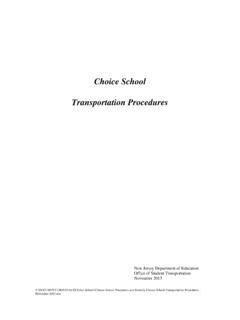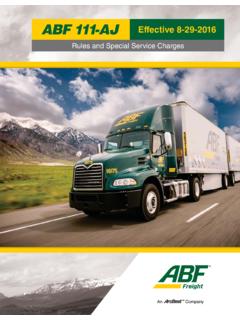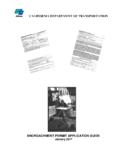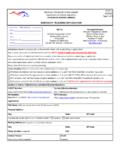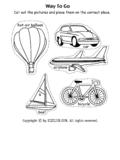Transcription of AFSC 2T2X1 AIR TRANSPORTATION SPECIALTY
1 DEPARTMENT OF THE AIR FORCE CFETP 2T2X1 . Headquarters US Air Force Parts I and II. Washington, DC 20330-1030 1 DEC 2016. afsc 2T2X1 . AIR TRANSPORTATION SPECIALTY . CAREER FIELD EDUCATION AND TRAINING PLAN. ACCESSIBILITY: Publications and forms are available on the e-Publishing website at for downloading or ordering. RELEASABILITY: There are no releasability restrictions on this publication. 1. CAREER FIELD EDUCATION AND TRAINING PLAN. AIR TRANSPORTATION SPECIALTY . afsc 2T2X1 . Table of Contents Part I. 4. Abbreviations/Terms Explained .. 5. Section A - General Information Purpose .. 8. Uses .. 8. Coordination and Approval .. 9. Section B - Career Progression and Information SPECIALTY Description .. 9. Duties and Responsibilities .. 9. Skill/Career 9. Apprentice (3) Level Journeyman (5) Level Craftsman (7) Level Superintendent (9) Level Training Decisions .. 10. Community College of the Air Force.
2 10. Career Field Path .. 12. Section C - Skill Level Training Requirements Purpose .. 13. SPECIALTY Qualification .. 13. Apprentice (3) Level Training Journeyman (5) Level Training Craftsman (7) Level Training Superintendent (9) Level Training Section D Task Qualification Training (TQT) 15. Section E - Resource 15. Section E - Transitional Training Guide .. 16. _____. OPR: 345 TRS/TRR. Certified By: CMSgt Timothy T. Gibson, AFCFM, (HQ USAF/A4LR). Supersedes: CFETP 2T2X1 , 01 March 2012. Pages: 29. 2. Part II. Section A - SPECIALTY Training Standard ..16. Section B - Course Objective List ..17. Section C - Support Material ..17. Section D - Training Course Section E - MAJCOM Unique Two attachments: 1. Qualitative Requirements (Proficiency Code Key).. 20. 2. SPECIALTY Training Standard (STS).. 22. MASTER. SENIOR BASIC. The falcon at the center of the badge symbolizes the Air Force.
3 It also symbolizes American military strength, dedication, and devotion to duty of transporters who support the generation and employment of aerospace forces across the full spectrum of warfare. In its talons, the falcon is holding the globe with three encircling arrows, symbolic of the extensive range of our logistics support mission and capability to sustain our forces by land, sea, or air. The olive branch surrounding the badge symbolizes the peace aerospace forces provide through a professional TRANSPORTATION community. 3. AIR TRANSPORTATION SPECIALTY . afsc 2T2X1 . CAREER FIELD EDUCATION AND TRAINING PLAN. Part I. Preface 1. This Career Field Education and Training Plan (CFETP) is a comprehensive education and training document that identifies life-cycle education and training requirements, training support resources, and minimum core task requirements for this SPECIALTY . The CFETP provides personnel a clear career path to success and covers all aspects of career field training.
4 Note: Civilians occupying associated positions will use Part II to support their duty position qualification training. 2. The CFETP consists of two parts. Supervisors plan, manage, and control training within the SPECIALTY using both parts of the plan. Part I provides information necessary for overall management of the SPECIALTY . Section A explains how everyone will use the plan. Section B identifies career field progression information, duties and responsibilities, training strategies, and career field path. Section C associates each level with SPECIALTY qualifications (knowledge, education, experience, training, and other). Section D indicates resource constraints ( funds, manpower, equipment, facilities). Section E identifies transition training plans for the 2T2X1 career field. Part II includes the following: Section A identifies the SPECIALTY Training Standard (STS) and includes duties, tasks, technical references to support training, Air Education and Training Command (AETC) conducted training, wartime tasks, core tasks, and correspondence course requirements; Section B, the Course Objective List, is currently reserved.
5 Section C identifies available training materials such as HQ AMC Qualification Training Packages (QTPs) which were developed to support upgrade and proficiency training. These packages are located on the following website: af/USAF/AFP40/d/s6925EC1353610FB5E044080 020E329A9/Files/a4t/a4tr/atsev/ ;. Section D has a training course index supervisors can refer to for available support training. This area lists both mandatory and optional courses; Section E identifies MAJCOM unique training requirements supervisors can use to determine additional qualification training. 3. Using this CFETP as a guide will ensure individuals in this SPECIALTY receive effective and efficient training at the appropriate point in their career. This plan enables us to train today's work force for tomorrow's jobs. At unit level, supervisors and trainers will use Part II to identify, plan, and conduct training commensurate with the overall goals of this plan.
6 4. ABBREVIATIONS/TERMS EXPLAINED. Advanced Distributed Learning System (ADLS). ADLS is an evolution of distributive learning (distance learning) that emphasizes collaboration on standards-based versions of reusable objects, networks, and learning management systems, yet may include some legacy methods and media. Advanced Training (AT). Formal course that provides individuals who are qualified in one or more positions of their Air Force SPECIALTY (AFS) with additional skills/knowledge to enhance their expertise in the career field. Training is for selected career Airmen at the advanced level of the AFS. Air Force Career Field Manager (AFCFM). The Air Force focal point for the designated career field within a functional community. Serves as the primary advocate for the career field, addressing issues and coordinating functional concerns across various staffs. Responsible for the career field policy and guidance.
7 Air Force Expeditionary Center (USAF EC). Air Mobility Command's center for continued training. Several courses related to afsc 2T2X1 are offered as unit-funded courses. Class quotas are controlled by HQ AMC/A4TR. and administered through the MFM. Air Force Installation and Mission Support Center (AFIMSC). A single intermediate-level staff performing major command-level installation and mission support activities. Parent organization for several field operating agencies to include the Air Force Security Forces Center, Air Force Civil Engineer Center, Air Force Installation Contracting Agency, the services directorate of the Air Force Personnel Center and other FOAs providing installation support capabilities. Air Force Logistics Readiness Board (AFLRB), Logistics Readiness Chiefs Advisory Group (LogR CAG). Meets at the direction of HQ AF/A4 to discuss significant issues, priorities and policies.
8 Provides advice and counsel to HQ AF/A4 concerning the enlisted logistics readiness community and resolves problems affecting the enlisted force and the overall mission. It also provides recommendations and initiatives for future training needs, career progression trends, and identifies information systems needs. Aerial Port Expediter (APEX). An aircraft cargo loading program that empowers APEX load directors to load and unload cargo on C-17/C-5 aircraft without a loadmaster. Air Reserve Component (ARC). All units, organizations and members of the Air National Guard (ANG) and the Air Force Reserve Command (AFRC). Air TRANSPORTATION Standard Evaluation Program (ATSEP). Provides AMC/A4T and unit commanders with an assessment of a unit's ability to perform key air TRANSPORTATION processes ensuring standardized, repeatable, technically compliant process execution, while promoting a culture of professional excellence and personal responsibility Air TRANSPORTATION Web Based Training (ATWBT).
9 Computer based instruction in areas directly related to items found in the 2T2X1 STS. Career Field Education and Training Plan (CFETP). A CFETP is a comprehensive, multipurpose document encapsulating the entire spectrum of education and training for a career field. It outlines a logical growth plan that includes training resources and is designed to make career field training identifiable, to eliminate duplication, and to ensure this training is budget defensible. Cargo Movement Operations System (CMOS). An Air Force standard system that integrates basic Department of Defense (DoD) and Air Force TRANSPORTATION policies and procedures. This system automates information management in receiving, shipment planning, packing and crating, and air/surface terminal work centers during normal operations and TRANSPORTATION mobility operations during wartime/crisis situations. 5. Continuation Training.
10 Additional training exceeding requirements with emphasis on present or future duty assignments. Core Task. Tasks the AFCFM identifies as minimum qualification requirements within an afsc , regardless of duty position. Core tasks may be specified for a particular skill level or in general across the afsc . Guidance for using core tasks can be found in the applicable CFETP narrative. (Reference: AFI 36-2201) Note: Core Tasks are identified by (*) in the 2T2X1 STS, Column 2. Education and Training Course Announcements (ETCA). Contains specific MAJCOM procedures, fund citations, reporting instructions, and listings for those formal courses conducted or managed by the MAJCOMs or field operating agencies. Enlisted SPECIALTY Training (EST). A mix of formal training (technical school) and informal training (on-the-job). to qualify and upgrade Airmen in each skill level of a SPECIALTY . Exportable Training.










